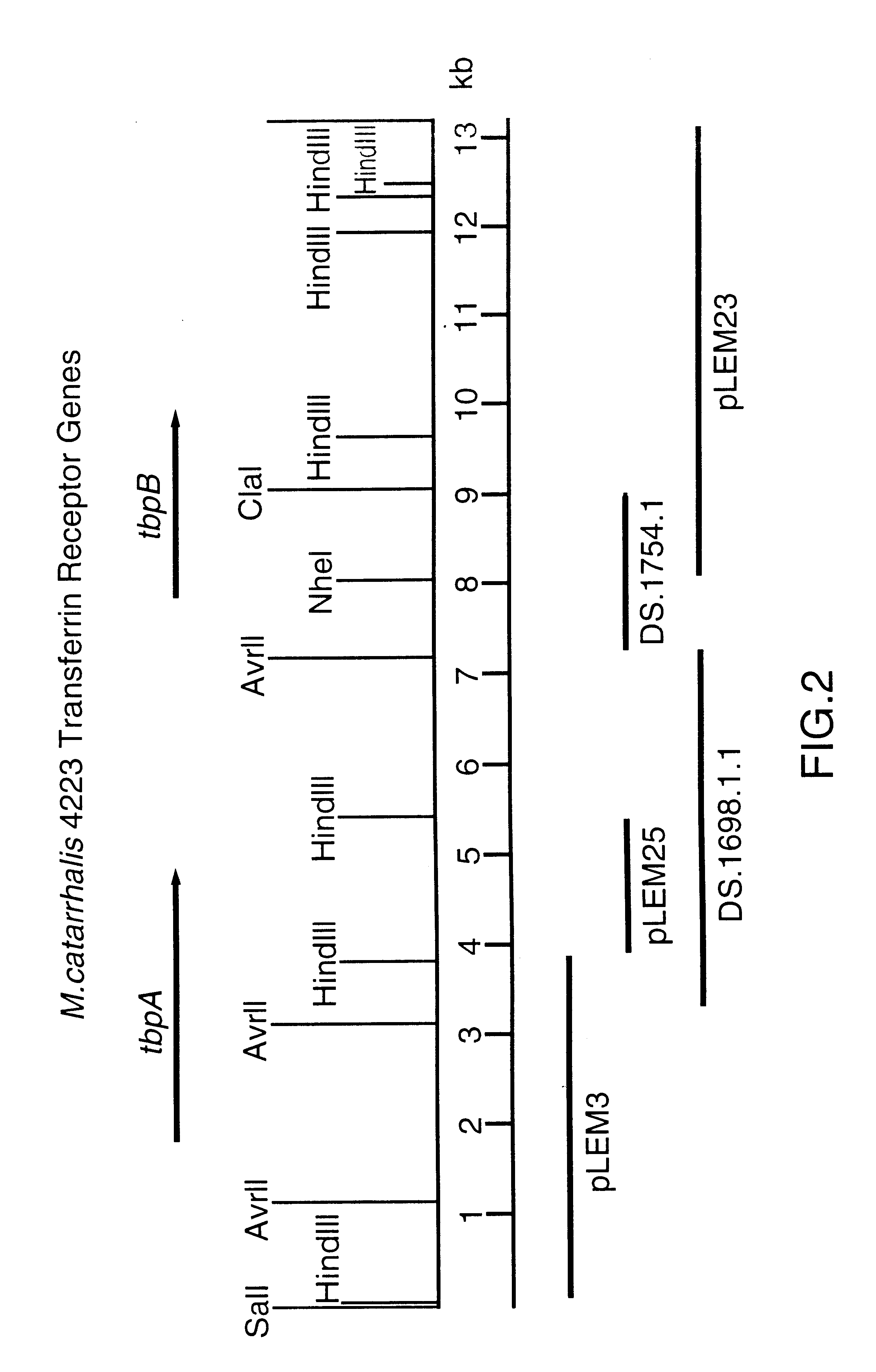Transferrin receptor of moraxella
a technology of moraxella and receptor, applied in the field of transferrin receptor, can solve problems such as serious diseases
- Summary
- Abstract
- Description
- Claims
- Application Information
AI Technical Summary
Benefits of technology
Problems solved by technology
Method used
Image
Examples
example 1
This Example illustrates the preparation and immunization of guinea pigs with Tbp1 and Tbp2 proteins from M. catarrhalis.
Tbp1 and Tbp2 proteins were obtained as follows:
Iron-starved crude total membrane preparations were diluted to 4 mg protein / ml in 50 mM Tris.HCl-1M NaCl, pH 8, in a total volume of 384 ml. Membranes were solubilized by the addition of 8 ml each of 0.5M EDTA and 30% sarkosyl and samples were incubated for 2 hours at room temperature, with gentle agitation. Solubilized membranes were centrifuged at 10K rpm for 20 min. 15 ml of apo-hTf-Sepharose 4B were added to the supernatant, and incubated for 2 hours at room temperature, with gentle shaking. The mixture was added into a column. The column was washed with 50 ml of 50 mM Tris.HCl-1 M NaCl-250 mM guanidine hydrochloride, to remove contaminating proteins. Tbp2 was eluted from the column by the addition of 100 ml of 1.5M guanidine hydrochloride. Tbp1 was eluted by the addition of 100 ml of 3M guanidine hydrochloride. ...
example 2
This Example illustrates the preparation of chromosomal DNA from M. catarrhalis strains 4223 and Q8.
M. catarrhalis isolate 4223 was inoculated into 100 ml of BHI broth, and incubated for 18 hr at 37.degree. C. with shaking. The cells were harvested by centrifugation at 10,000.times.g for 20 min. The pellet was used for extraction of M. catarrhalis 4223 chromosomal DNA.
The cell pellet was resuspended in 20 ml of 10 mM Tris-HCl (pH 7.5)-1.0 mM EDTA (TE). Pronase and SDS were added to final concentrations of 500 .mu.g / ml and 1.0%, respectively, and the suspension was incubated at 37.degree. C. for 2 hr. After several sequential extractions with phenol, phenol:chloroform (1:1), and chloroform:isoamyl alcohol (24:1), the aqueous extract was dialysed, at 4.degree. C., against 1.0 M NaCl for 4 hr, and against TE (pH 7.5) for a further 48 hr with three buffer changes. Two volumes of ethanol were added to the dialysate, and the DNA was spooled onto a glass rod. The DNA was allowed to air-dry...
example 3
This Example illustrates the construction of M. catarrhalis chromosomal libraries in EMBL3.
A series of Sau3A restriction digests of chromosomal DNA, in final volumes of 10 .mu.L each, were carried out in order to optimize the conditions necessary to generate maximal amounts of restriction fragments within a 15 to 23 kb size range. Using the optimized digestion conditions, a large-scale digestion was set up in a 100 .mu.L volume, containing the following: 50 .mu.L of chromosomal DNA (290 .mu.g / ml), 33 .mu.L water, 10 .mu.L 10.times.Sau3A buffer (New England Biolabs), 1.0 .mu.L BSA (10 mg / ml, New England Biolabs), and 6.3 .mu.L Sau3A (0.04 U / .mu.L). Following a 15 min. incubation at 37.degree. C., the digestion was terminated by the addition of 10 .mu.L of 100 mM Tris-HCl (pH 8.0)-10 mM EDTA-0.1% bromophenol blue-50% glycerol (loading buffer). Digested DNA was electrophoresed through a 0.5% agarose gel in 40 mM Tris acetate-2 mM Na.sub.2 EDTA.2H.sub.2 O (pH8.5) (TAE buffer) at 50 V fo...
PUM
| Property | Measurement | Unit |
|---|---|---|
| molecular weights | aaaaa | aaaaa |
| molecular weights | aaaaa | aaaaa |
| temperatures | aaaaa | aaaaa |
Abstract
Description
Claims
Application Information
 Login to View More
Login to View More - R&D
- Intellectual Property
- Life Sciences
- Materials
- Tech Scout
- Unparalleled Data Quality
- Higher Quality Content
- 60% Fewer Hallucinations
Browse by: Latest US Patents, China's latest patents, Technical Efficacy Thesaurus, Application Domain, Technology Topic, Popular Technical Reports.
© 2025 PatSnap. All rights reserved.Legal|Privacy policy|Modern Slavery Act Transparency Statement|Sitemap|About US| Contact US: help@patsnap.com



